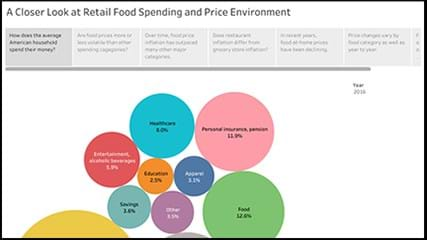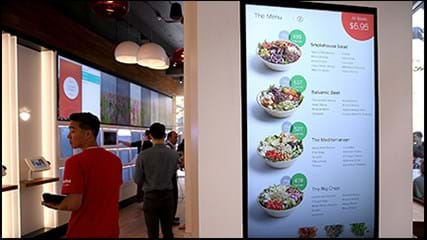
Customer-Focused Research: How ERS Information Delivers for the American People
As the third highest ranked agricultural economics institution in the world, ERS has a long history of providing evidence-based research and analysis that helps USDA and Congress make policies that serve farmers, consumers, rural residents, and businesses. The Economic Research Service (ERS) conducts research and analysis that provides insight on agriculture and food issues that directly affect everyone – from the farmers who grow our food, to grocery shoppers feeding their families. The following examples show how ERS serves these customers.
Farmers, Agribusinesses, and Financial Industries
ERS provides research, data, and analyses that inform a variety of decisions that affect the farm sector and the lives of farm families. These analyses provide evidence-based information for the design of policy that directly affects farmers, like the 2018 Farm Act. In addition, farmers can use ERS research and data to inform decisions about future investments in equipment or crop management planning, such as determining what crop is likely to deliver them the best return. Agribusinesses (like farm equipment companies) and farm lenders rely on ERS information in planning their services and investment allocations, such as deciding how much equipment to order for farmer purchases and anticipating what farmer demand might be for loans in the coming years.
The ERS commodity outlook program delivers timely and objective information about agricultural markets and—working closely with the World Agricultural Outlook Board, the Foreign Agricultural Service, and other USDA agencies—provides projections of U.S. and world agricultural commodity production, consumption, and trade. These monthly outlook reports and data are among the most widely used ERS products, especially by the agriculture and finance communities to make plans for the future. This foundational work enables ERS to provide quick analysis for USDA leadership and Congress, and statistical data and analysis to inform decision-makers in the public and private sectors.
Each month, USDA publishes annual supply and demand forecasts for major crop and livestock commodities for the nation and the world. These forecasts appear in USDA's World Agricultural Supply and Demand Estimates (WASDE). In September 2017, ERS began releasing a monthly visualization that provides key data and highlights from WASDE. ERS analysts—as well as those from other agencies—have an important role in conducting research and analyses that help shape USDA’s WASDE forecasts for major grains, soybeans, and livestock. These forecasts are used as benchmarks in the marketplace because of their comprehensive nature, objectivity, and timeliness. By defining the fundamental conditions in commodity markets, these forecasts affect decisions made by farmers and ranchers, financial industries, other businesses, and governments.
In addition, each year, ERS and USDA’s National Agricultural Statistics Service (NASS) conduct the Agricultural Resource Management Survey (ARMS), a nationally representative survey covering about 5,000 fields and 30,000 farms in the United States. ARMS is USDA's primary source of information on the financial condition, production practices, and resource use of America's farm businesses and on the economic well-being of America's farm households.
Using data from ARMS and other sources, ERS economists produce research reports like America’s Diverse Family Farms, an annual snapshot of the structure and condition of U.S. farms, as well as data sources like Commodity Costs and Returns estimates for the United States and across major production regions for corn, soybeans, wheat, cotton, grain sorghum, rice, peanuts, oats, barley, milk, hogs, and cow-calf operations.
ERS also uses ARMS to produce data products such as Farm Household Income and Characteristics - the most up-to-date household income forecast (future) and estimates (past) for principal operators of U.S. family farms; Farm Crop Production Practices - estimates on farm practices such as pesticide use, irrigation, and conservation; and Farm Income and Wealth Statistics - estimates of historical U.S. and State-level farm income and wealth as well as U.S.-level forecasts for the current calendar year.
In 2018, ERS consulted with a targeted group of stakeholders from the private sector, commodity organizations, and the academic community to re-design its Tailored Reports using ARMS data. The new interface enables more data interaction, the ability to do on-the-go analysis, and makes downloads easier.
 ERS also develops monthly forecasts of the CPI (Consumer Price Index) and Producer Price Index (PPI) for food. ERS reports the current index level for food, examines changes in the CPI for food, and constructs forecasts of the CPI for food for the next 12-18 months. Forecasting the CPI for food has become increasingly important due to the changing structure of food and agricultural economies and the important signals the forecasts provide to farmers, processors, wholesalers, consumers, and policymakers. Professionals working throughout the food industry use ERS’s forecasts to project costs, expenditures, or demand for their products and services. ERS also released a Food Price Environment Visualization, which examines factors including food prices by food category, by city, grocery store vs. restaurant, and how much Americans spend on food.
ERS also develops monthly forecasts of the CPI (Consumer Price Index) and Producer Price Index (PPI) for food. ERS reports the current index level for food, examines changes in the CPI for food, and constructs forecasts of the CPI for food for the next 12-18 months. Forecasting the CPI for food has become increasingly important due to the changing structure of food and agricultural economies and the important signals the forecasts provide to farmers, processors, wholesalers, consumers, and policymakers. Professionals working throughout the food industry use ERS’s forecasts to project costs, expenditures, or demand for their products and services. ERS also released a Food Price Environment Visualization, which examines factors including food prices by food category, by city, grocery store vs. restaurant, and how much Americans spend on food.
Consumers
ERS conducts research that informs consumers about policies and trends that affect them at home or when they go to a restaurant, grocery store, or farmers market. Consumers can also use this information to make their own food purchasing decisions.
 For example, an ERS report, Beyond Nutrition and Organic Labels—30 Years of Experience With Intervening in Food Labels explains the history of food labeling legislation, consumer demand for certain food traits, and the current trends in food labeling by manufacturers. It also discusses that certain labeling practices adopted by manufacturers may be confusing to consumers, and helps to clarify what those labels really mean. Another recent report examines how consumers use restaurant menu labels. The Association Between Restaurant Menu Label Use and Caloric Intake examines how restaurant menu label use affects consumers’ daily caloric intakes. In addition, America’s Eating Habits: Food Away From Home describes the growing availability of food away from home (FAFH), and how consumers decide where and how much to consume, and how their choices impact diet quality.
For example, an ERS report, Beyond Nutrition and Organic Labels—30 Years of Experience With Intervening in Food Labels explains the history of food labeling legislation, consumer demand for certain food traits, and the current trends in food labeling by manufacturers. It also discusses that certain labeling practices adopted by manufacturers may be confusing to consumers, and helps to clarify what those labels really mean. Another recent report examines how consumers use restaurant menu labels. The Association Between Restaurant Menu Label Use and Caloric Intake examines how restaurant menu label use affects consumers’ daily caloric intakes. In addition, America’s Eating Habits: Food Away From Home describes the growing availability of food away from home (FAFH), and how consumers decide where and how much to consume, and how their choices impact diet quality.
ERS has also published many recent reports based on data from its National Household Food Acquisition and Purchase Survey (FoodAPS), the first nationally representative survey to collect unique and comprehensive data about American household food purchases and acquisitions. Using this data, ERS can analyze factors influencing food demand, household well-being, and how the food environment and access to various types of food stores and restaurants are related to food choices, food security, health, and obesity.
In addition, ERS examines food safety issues that affect consumers, farmers, and the food industry. Trends in Food Recalls: 2004-2013 studied trends in food product recalls over a decade and identified the most common types of foods recalled.
Rural Residents
ERS’s rural research explores how investments in businesses, communities, and people affect the capacity of rural economies to prosper in a changing global marketplace. The agency analyzes how employment opportunities, Federal policies, demographic trends, and public investment in infrastructure and technology enhance economic opportunity and quality of life for rural Americans.
 As part of USDA’s Interagency Task Force on Agriculture and Rural Prosperity, ERS researchers conducted a robust and in-depth analysis to identify the opportunities and challenges for rural prosperity in America. The report, published in early FY 2018, recommended expanding e-connectivity; advancing educational, healthcare, housing and utilities infrastructure; improving career training, apprenticeships, and access to agriculture and rural jobs; and harnessing technological innovation. See the Task Force’s final report to the President.
As part of USDA’s Interagency Task Force on Agriculture and Rural Prosperity, ERS researchers conducted a robust and in-depth analysis to identify the opportunities and challenges for rural prosperity in America. The report, published in early FY 2018, recommended expanding e-connectivity; advancing educational, healthcare, housing and utilities infrastructure; improving career training, apprenticeships, and access to agriculture and rural jobs; and harnessing technological innovation. See the Task Force’s final report to the President.
Partnering with the Farm Foundation, ERS organized a workshop on the Economic Returns to Rural Infrastructure Investment. The workshop brought together applied researchers; national, state, and local governments; and rural infrastructure stakeholders (including the Rural Broadband Association, the Farm Credit Council, the American Trucking Association, and farmers) to examine the impact of rural infrastructure investments on economic activity. The workshop highlighted the work that has been done, encouraged additional work by researchers, and identified areas where additional knowledge is needed.
Congress and USDA
In March 2018, Congress directed ERS to report on the economic benefits of breastfeeding, including its potential cost-savings for the Special Supplemental Nutrition Program for Women, Infants, and Children (WIC): “As Congress looks for ways to reduce Federal healthcare spending, it is important to understand the preventive impact of breastfeeding and WIC’s initiatives within broader healthcare spending.” This is just one example of the work ERS does to support evidence-based policymaking for Congress. ERS released the Congressionally-requested report, The Economic Impacts of Breastfeeding: A Focus on USDA’s Special Supplemental Nutrition Program for Women, Infants, and Children (WIC), in February 2019.
In addition, ERS is working with USDA as part of the Department’s initiative to address food loss and waste. An ERS report, The Estimated Amount, Value, and Calories of Postharvest Food Losses at the Retail and Consumer Levels in the United States, estimates that approximately 133 billion pounds of food (worth $161 billion, and about 30-40 percent of the U.S. food supply) were lost at the retail and consumer levels in 2010. ERS is working to improve its estimates of the food available for consumption and of food loss, such as obtaining updated estimates of food loss for fresh fruit, vegetables, meat, poultry, and seafood in retail stores. More refined estimates and greater awareness of the amount of food loss—and where the loss occurs—would better inform government policy decisions, food handling practices and technologies, consumer habits, and other actions that reduce food waste and conserve resources.
Everyone
ERS continuously improves its products and its delivery of timely economic food and agriculture research based on stakeholder needs, customer feedback, and best practices. As part of its digital strategy, ERS made a variety of website improvements in 2018, including a refreshed web presence for its online magazine, Amber Waves. New features include an easier-to-navigate homepage, improved filtering, and a new infographic gallery. Over the past 15 years, Amber Waves has built an audience of more than 5,000 e-mail subscribers, representing business, industry, researchers, and government. ERS posts new issues of Amber Waves monthly on the ERS website with additional articles released concurrently with new reports throughout the year.

